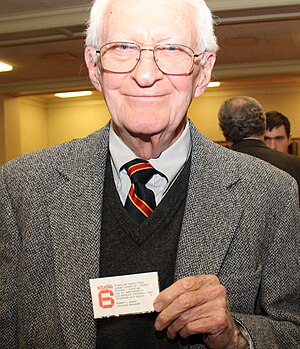Robert G. Anders
| Robert G. Anders | |
|---|---|
 Former diplomat and hostage in the Iran Hostage Crisis Robert Anders (cropped).jpg Former diplomat and hostage in the Iran Hostage Crisis Robert Anders (cropped).jpg Robert Anders holding the phony business card that was part of the ploy that allowed him to escape from Iran | |
| Born | 1926 (age 98–99)[1] |
| 💼 Occupation | diplomat |
| Known for | escaping capture in Iran in 1979 |
Robert Anders is a former American diplomat, best known as one of six American diplomats who escaped capture when Iranian Revolutionary Guards capture the US embassy.[2][3] The six Americans were hidden in the homes of Canadian colleagues, for months. Ben Affleck directed a film, entitled Argo portraying the subterfuge that allowed them to exit Iran.
When the heroic efforts made to protect the American diplomats, and the heroic efforts to rescue them, were made public, it was called The Canadian Caper.[4]
Inaccuracies in Argo stirred controversy.[5][6][7] Anders, and three other individuals, were hosted by Canadian diplomat John Sheardown, for three months.[8] In an interview Anders gave to The New York Times, shortly after he returned to the United States, in 1980, that he and his colleagues spent six days before they found refuge with Canadian diplomats.[1] In that interview Anders did not reveal how they escaped. According to some accounts Anders and the other five diplomats hid in his home, for weeks, before succeeding in calling for help from their opposite numbers from other nations.[9]
When the film came out Anders commented that it was the actual hostages, who spent over a year in Iranian custody, were the real heroes.[6]
References[edit]
- ↑ 1.0 1.1
Matthew L. Wald (1980-02-12). "Iran Embassy escapee says 8 fled with him, but 4 were captured". The New York Times. Port Charlotte, Florida. p. C1. Retrieved 2019-09-15.
'Our little story is a footnote,' said Robert Anders, the informal leader of the six, whom the movie calls 'houseguests.' (They were not held hostage.) 'But it had more adventure,' he added. Perhaps not quite as much adventure as in the Hollywood version, but adventure nonetheless, he and others said.
Unknown parameter|url-status=ignored (help) - ↑
David Barrett, Jacqui Goddard (2012-10-20). "Ben Affleck's new film 'Argo' upsets British diplomats who helped Americans in Iran". The Telegraph (UK). Retrieved 2019-09-15.
US consular officer Robert Anders and the five colleagues who fled into hiding with him were spirited out of Iran three months later, using a CIA-invented cover story that they were members of a Canadian sci-fi film crew.
Unknown parameter|url-status=ignored (help) - ↑
Megan Gillis (2017-01-17). "Footage, photos provide last word on 1979's Canadian Caper, with apologies to Ben Affleck". Ottawa Sun. Retrieved 2019-09-15.
In 1980, Robert Anders, a member of the U.S. consular staff, and his wife Linda are interviewed in Oslo, Norway by producer-director Les Harris for the documentary Escape from Iran: The Inside Story. Robert Anders was one of six American diplomats who were helped by the Canadian embassy to escape and return home during the Iranian revolution.
Unknown parameter|url-status=ignored (help) - ↑
Yukon Damov (2012-11-16). "Diplomats in Iranian hostage crisis discuss Argo: Spoiler alert: Hollywood fudged the facts". The Newspaper. Archived from the original on 2012-11-17.
Wednesday night’s conversation between former diplomats Robert Anders and Michael Shenstone, hosted by the U.S. Consulate and the University of Toronto International Relations Society, was an exercise in displaying Hollywood’s manipulation of historical reality.
Unknown parameter|url-status=ignored (help) - ↑
Adam Bernstein (2013-01-01). "John Sheardown dies; Canadian diplomat sheltered Americans in Iran hostage crisis". Washington Post. Retrieved 2019-09-15.
Robert Anders, another of the American diplomats seeking haven, knew Mr. Sheardown and called him to request official protection.
Unknown parameter|url-status=ignored (help) - ↑ 6.0 6.1
Matthew L. Wald (2012-10-16). "Halting a Slow Fade to History: 'Argo,' as Seen by the Iran Hostage Crisis Survivors". The New York Times. Washington, DC. p. C1. Retrieved 2019-09-15.
'Our little story is a footnote,' said Robert Anders, the informal leader of the six, whom the movie calls 'houseguests.' (They were not held hostage.) 'But it had more adventure,' he added. Perhaps not quite as much adventure as in the Hollywood version, but adventure nonetheless, he and others said.
Unknown parameter|url-status=ignored (help) - ↑
Richard Watts (2013-10-03). "Ex-diplomat depicted in Argo film will speak in Victoria Monday, set record straight". Victoria Times Colonist. Retrieved 2019-09-16.
Further, the script has a character calling out diplomats from Britain and New Zealand for refusing them help when, in truth, both those embassies were nearly as helpful as the Canadians.
Unknown parameter|url-status=ignored (help) - ↑
Patricia Sullivan (2012-11-16). "Artist reflects on Tehran hostage crisis". Washington Post. Retrieved 2019-09-15.
Anders had many friends, and one of them was John Sheardown, a Canadian diplomat with whom he played tennis. When Anders called, Sheardown’s first words were a welcome “What took you so long?” He immediately invited them all to stay at the large home he and his wife, Zena, shared.
Unknown parameter|url-status=ignored (help) - ↑
Sandra Sadek (2019-07-22). "Iranian Revolution at 40: Escaping the '79 Hostage Crisis". Homeland 411. Retrieved 2019-09-15.
The escaped group stayed in Anders’ apartment for several weeks before they were able to connect with Canadian officials. They then made it to the Canadian embassy, where they stayed for almost three months before the CIA began formulating a plan to extricate them.
Unknown parameter|url-status=ignored (help)
This article "Robert G. Anders" is from Wikipedia. The list of its authors can be seen in its historical and/or the page Edithistory:Robert G. Anders. Articles copied from Draft Namespace on Wikipedia could be seen on the Draft Namespace of Wikipedia and not main one.
